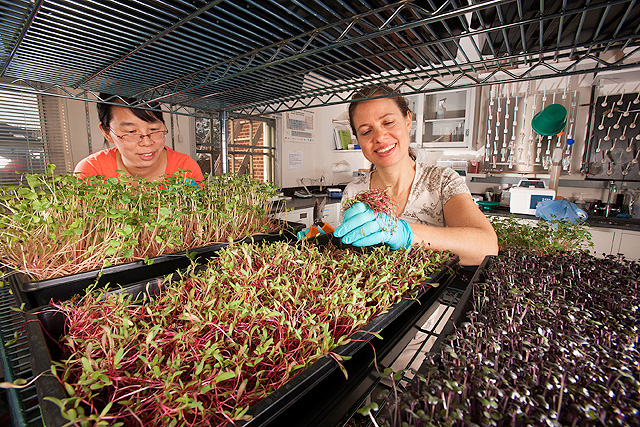Washington, DC, USA
January 23, 2014

Visiting scientist Liping Kou (left) and technician Ellen Turner harvest different types of microgreens for shelf-life studies and nutrient analyses. Photo by Peggy Greb.
"Microgreens" is a marketing term used to describe edible greens which germinate from the seeds of vegetables and herbs and are harvested without roots at the seedling stage. The plants at the seedling stage have two fully expanded cotyledons, or seed leaves. They are considered a specialty genre of colorful greens that are good for garnishing salads, soups, plates and sandwiches.
A U.S. Department of Agriculture (USDA) researcher has led a team of scientists who analyzed the key nutrients in 25 different varieties of vegetable microgreens. The study results could be used to estimate levels of vitamins and nutrients in microgreens, according to the scientists.
The study was led by Agricultural Research Service (ARS) plant physiologist and national program leader Gene Lester at Beltsville, Md. ARS is USDA's chief intramural scientific research agency.
The team determined the concentration of essential vitamins and carotenoids in the microgreens. Key nutrients measured were ascorbic acid (vitamin C), tocopherols (vitamin E), phylloquinone (vitamin K), and beta-carotene (a vitamin A precursor), plus other related carotenoids in the cotyledons that are critical for human health and function.
The team showed that different microgreens contained widely differing amounts of vitamins and carotenoids. Total vitamin C content ranged from 20 to 147 milligrams (mg) per 100 grams of cotyledon fresh weight, depending on which plant species was being tested. The amounts of the carotenoids beta-carotene, lutein/zeaxanthin, and violaxanthin ranged from about 0.6 mg to 12.1 mg per 100 grams of fresh weight. For comparison, an average apple weighs 100-150 grams. In general, microgreens contained considerably higher levels of vitamins and carotenoids—about five times greater—than their mature plant counterparts.
Among the 25 microgreens tested, red cabbage, cilantro, garnet amaranth, and green daikon radish had the highest concentrations of vitamin C, carotenoids, vitamin K and vitamin E, respectively. Growing, harvesting, and handling conditions may have a considerable effect on nutrient content. Additional studies are being conducted to evaluate the effect of agricultural practices on nutrient retention.
Read more about this research in the January 2014 issue of Agricultural Research magazine.
Verduras especiales ofrecen mucha nutrición
"Microvegetales" es un término de mercadotecnia que se usa para describir las verduras que germinan de las semillas de verduras y hierbas y son cosechadas cuando todavía son plántulas. Las plantas en esta etapa tienen dos cotiledones (hojas de semilla) completamente extendidas. Se consideran estas verduras como un género especial muy útil para guarnecer las ensaladas, las sopas y los bocadillos.
Un científico del Servicio de Investigación Agrícola (ARS) y sus colaboradores han analizado los nutrientes en 25 diferentes variedades de microvegetales. Los resultados podrían ser útiles en calcular los niveles de vitaminas y nutrientes en los microvegetales, según los científicos.
El estudio fue dirigido por fisiólogo de plantas Gene Lester con el ARS en Beltsville, Maryland. ARS es la agencia principal de investigaciones científicas del Departamento de Agricultura de EE.UU. (USDA por sus siglas en inglés).
El grupo determinó las concentraciones de las vitaminas y los carotenoides en los microvegetales. Los investigadores midieron los niveles del ácido ascórbico (vitamina C), los tocoferoles (vitamina E), la filoquinona (vitamina K) y el beta-caroteno, el cual es un precursor de vitamina A, juntos con otros carotenoides en los cotiledones que son imprescindibles para la salud humana.
El grupo demostró que los diferentes microvegetales contuvieron una gama amplia de vitaminas y carotenoides. El contenido total de vitamina C varió de 20 a 147 miligramos (mg) por 100 gramos de peso fresco de los cotiledones, dependiendo de la especie de planta. Las cantidades de los carotenoides—beta-caroteno, zeaxantina, luteina y violaxantina—variaron de 0,6 mg a 12,2 mg por 100 gramos de peso fresco. Para comparación, una manzana típicamente tiene un peso de 100 a 150 gramos. Por lo general, los microvegetales contuvieron niveles considerablemente más altos de vitaminas y carotenoides–hasta cinco veces más altos—comparados con sus homólogos maduros.
Entre los 25 microvegetales probados, el col rojo, el cilantro, el amaranto granate, y el rábano verde daikon tuvieron las concentraciones más altas de vitamina C, carotenoides, vitamina K y vitamina E, respectivamente. Las condiciones de cultivar, cosechar y manejar los microvegetales pueden tener un efecto considerable en el contenido nutricional. Otros estudios están en curso para evaluar el efecto de las prácticas agrícolas en la retención de nutrientes por los microvegetales.
Lea más sobre este estudio en la revista 'Agricultural Research' de enero del 2014.